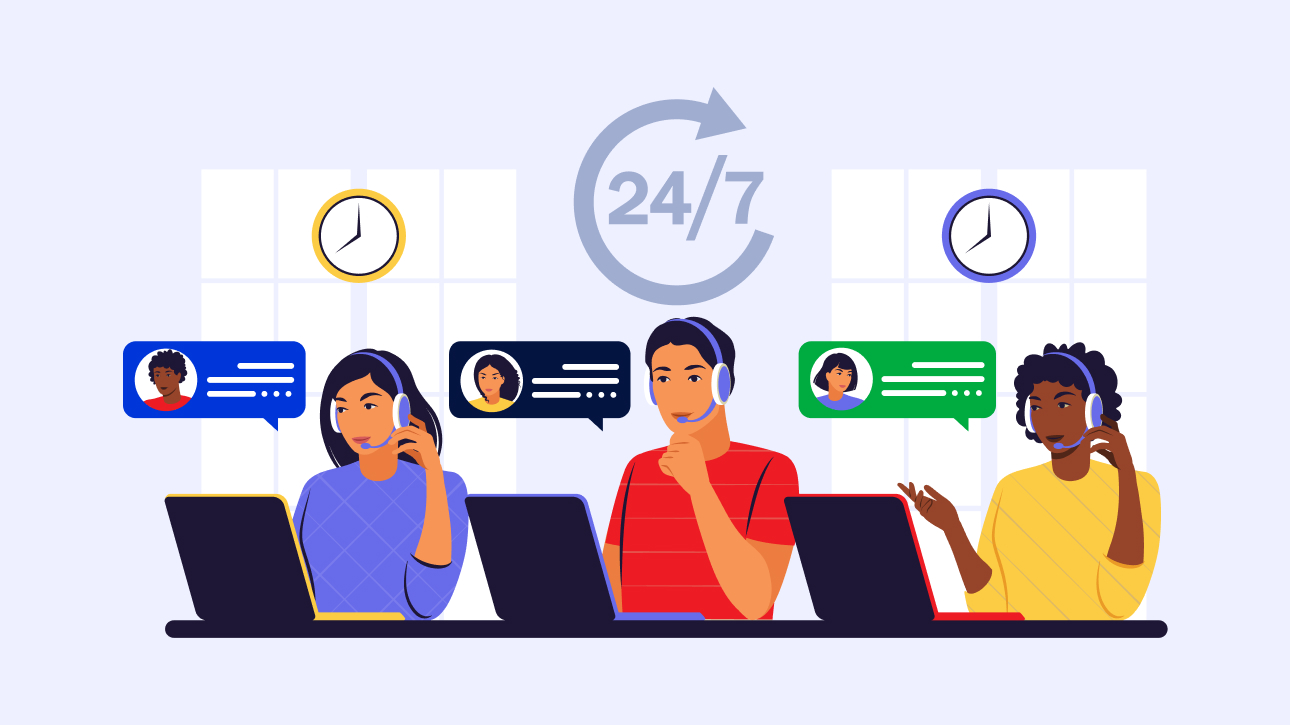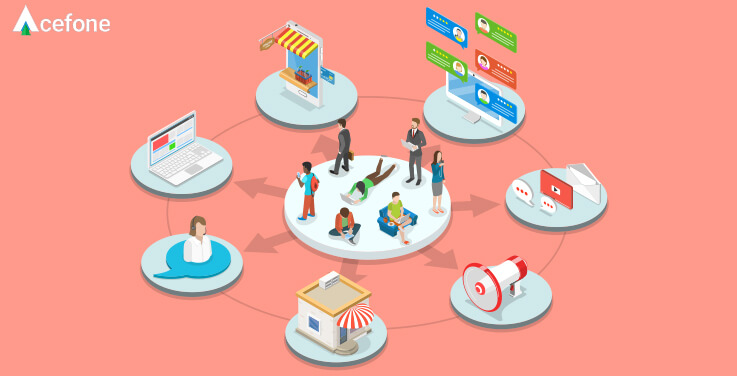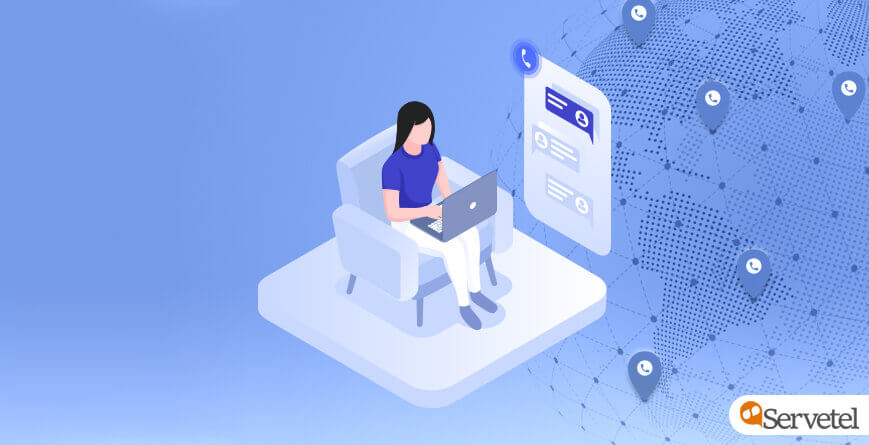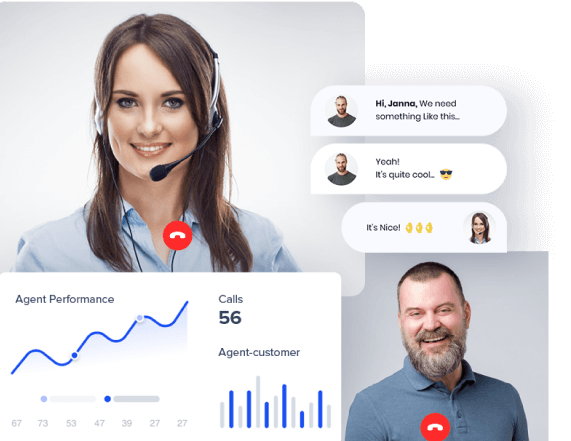Every successful business has one common denominator, a happy customer. One of the most important ways to provide your customers with a great experience is seamless communication. That involves taking care of every communication channel, most importantly calls. However, managing calls efficiently can be overwhelming.
Long wait times, missed calls, and inefficient routing frustrate both customers and your team. To deliver fast, effective support and build lasting relationships, you need a powerful call management solution. This is where inbound call center software comes into play. They help you ensure every customer gets the attention they deserve, without the chaos.
In this guide, we’ll help you understand the features, benefits, and future of inbound call center software to help you make an informed decision for your business.
What is an Inbound Call Center?
An inbound call center is a customer service hub where agents handle incoming calls for support, inquiries, or order processing. Unlike traditional landlines, these cloud-based solutions enable remote access, greater scalability, and seamless call management.
When it comes to real-life applications, inbound call software can help you enhance efficiency in multiple aspects of communication. Here are a few most popular use cases:
- Customer Support: Set up virtual support stations that help handle routine inquiries, troubleshoot, and resolve issues efficiently.
- Order Processing: Assist customers with placing, tracking, and managing orders.
- Appointment Scheduling: Book, confirm, or reschedule appointments seamlessly.
- Technical Support: Provide real-time assistance for product or service-related issues.
Difference Between Inbound and Outbound Call Software
| Feature
|
Inbound Call Center Software
|
Outbound Call Center Software
|
| Primary Function
|
Handles incoming calls from customers
|
Handles outgoing calls to customers or leads
|
| Use Case | Customer support, inquiries, order status, complaints | Telemarketing, sales calls, customer follow-ups |
| Call Volume | Typically deals with unpredictable, varied call volume | Manages a high volume of outgoing calls in a set pattern |
| Key Features | IVR, ACD, CRM integration, call routing, call queuing | Autodialing, predictive dialing, call scripting |
| Agent Focus | Focus on problem-solving and customer service | Focus on sales, lead generation, or customer engagement |
| Call Flow | Calls are initiated by customers | Calls are initiated by the business |
| Real-Time Interaction | High levels of real-time interaction with customers | Limited real-time interaction; often pre-recorded messages or scripts |
| Scalability | Scalable to handle incoming traffic spikes
|
Scalable to handle large volumes of outbound calls |
Benefits of Using Inbound Call Center Software

Now that you understand how inbound call centers work, let’s look at a few advantages they offer:
Enhanced Customer Experience
Providing your customers with good experience requires a holistic approach. One of the most important pillars is personalization. According to a recent McKinsey study, 71% of your customers expect personalized interactions.
Inbound call center software can help you enhance personalization in every interaction your agents have with customers. By ensuring customers are directed to the right agent, they streamline call management and reduce wait times. These factors significantly improve customer satisfaction and loyalty.
Improved Agent Productivity
Boosting your team’s efficiency is crucial for delivering top-notch customer service. When routine tasks are automated, agents have more time to focus on solving complex issues, which means faster resolutions and happier customers. Plus, more efficient workflows help reduce stress, leading to a more motivated and productive team.
Automation features like ACD and IVR take care of repetitive tasks, allowing your team to focus on issues that require more attention. CRM triggers streamline workflows even more by automating task assignments and follow-ups. Real-time monitoring and feedback also help improve their performance, making sure they continuously provide a high-quality service.
Cost Efficiency
Keeping unnecessary costs in check is important for your business’s growth. Automating routine tasks with inbound call center software can be a big cost saving factor. By automating call routing and enabling self-service options with IVR, you will need less manual labor. This way, you can save big bucks on staffing and resources.
Other than that, cloud-based inbound call software removes the need for hefty upfront investments in hardware and ongoing maintenance costs.
Scalability
As your business grows, you will need to expand and diversify customer service. Most modern inbound call center software services like Acefone’s are easily scalable. Greater scalability means seamless handling of higher call volumes, more customer touchpoints, and expanding teams without sacrificing quality.
This adaptability will help you keep up with changing demands and stay ahead of the competition.
Flexibility
Today’s workforce is more mobile than ever. Tech industry alone has 67.8% of the total employees working from home. A significant proportion of this workforce consists of sales and support teams. Hence, a flexible solution that supports remote and hybrid work environments is the need of the hour.
Cloud-based inbound call software allows agents to work from anywhere, ensuring that customer service doesn’t stop, no matter where your team is.
Key Features of Inbound Call Center Software
The benefits above are achievable owing to the advanced features of the modern inbound call center solutions.
Let’s take a look at the essential features that power seamless communication:
Automatic Call Distribution (ACD)
The ACD is a critical feature for optimizing call flow in inbound call centers. It ensures that calls are efficiently routed to the most appropriate agent or department based on predetermined criteria, such as the customer’s issue type, agent skills, or availability. This minimizes the chances of long wait times and reduces the chances of customers being transferred multiple times.
Interactive Voice Response (IVR)
The IVR is a self-service technology that allows customers to interact with an automated system to complete tasks without needing to speak with a live agent. When a customer calls in, the IVR system provides pre-recorded messages and voice prompts. Customers can use them to navigate through the menu and get answers to billing inquiries, technical support, or general information.
This helps you save time, optimize resources, and improve operational efficiencies.
Read this Article “What is IVR Blasting?” here.
Call Queuing
Call queuing is a key component for managing high call volumes efficiently. It organizes incoming calls into a virtual line, ensuring they are queued and answered in the order it was received.
While on call, the customers are kept informed about their queue position and provided with an estimated wait time. This helps reduce frustration and helps manage expectations.
Call Monitoring and Recording
Call monitoring and recording are essential tools for maintaining high standards of customer service. With monitoring, supervisors can listen to live calls to ensure agents are adhering to company guidelines and providing excellent service. They can also step in if necessary to offer real-time coaching or assistance to the agent.
Call recordings, on the other hand, are valuable for training purposes, helping new agents learn from real-world examples. They are essential for quality assurance, allowing you to evaluate the effectiveness of customer service and identify areas for improvement. They also serve as an important tool for dispute resolution, as the conversation can be reviewed if a customer complains.
Analytics and Reporting
Analytics and reporting tools provide you with valuable insights into how your inbound call center is performing. Key metrics such as call volume, average handle time (AHT), first-call resolution rates, and customer satisfaction levels can be tracked and analyzed.
This data helps you make informed decisions about staffing levels, training needs, and operational improvements. You also get a glimpse into the unusual patterns that may require attention, such as high call abandonment rates or increased customer wait times.
By regularly analyzing this data you can ensure continuous improvement and help your team adapt to evolving customer needs.
CRM Integration
When it comes to silo-free data management, CRM integration is a game-changer for inbound call centers. With integration, agents get instant access to customer information and interaction history.
When a customer calls, the system automatically pulls up their profile, displaying relevant details such as recent purchases, previous support issues, and personal preferences. This allows agents to provide personalized and context-aware service, reducing the need for customers to repeat themselves.
This seamless integration improves efficiency by enabling agents to resolve customer issues faster. It also allows agents to update customer profiles in real-time, ensuring that all customer data is up to date and accessible for future interactions.
Choose reliable software providers with robust support systems. Regular maintenance and updates minimize technical disruptions.
Choosing the Right Inbound Call Center Software
Selecting the right inbound call center service is a crucial decision because it has a direct impact on the interaction quality and call management. Here are key considerations to help you find and choose the best inbound call center service for your business:
1. Understand Your Business Needs
Before evaluating any software, it’s important to assess your business’s specific needs. Consider the type of customer service you offer, the volume of incoming calls, and the complexity of your customer interactions. For example, if you have a tech support center, you may require more advanced features like ticketing systems or live chat integration. Whereas for a retail business, you might have to prioritize basic call routing and CRM integration.
Understanding these needs will help you find software that offers the features most critical to your success.
2. Ensure All the Key Features Are Available
Look for software that offers a comprehensive set of features that will streamline your operations and improve customer service.
Some essential features to consider include:
- Interactive Voice Response (IVR)
- Automatic Call Distribution (ACD)
- CRM Integration
- Call Queuing and Callback Options
- Real-time Analytics and Reporting
Modern inbound call center services like Acefone offer all these and more.
What is Inbound Call Center Software? A Comprehensive Guide
3. Check for Scalability
The right inbound call center software should be able to scale with your business to handle increased call volumes, more agents, or new service channels (e.g., chat, email, social media). Get a cloud-based solution that offers great flexibility, allowing you to expand or adjust your capacity without the need for significant upfront investments in hardware or infrastructure.
4. Make Sure It’s User-Friendly
The software’s ease of use is crucial for both agents and supervisors. Complicated interfaces or difficult-to-navigate systems can result in longer call handling time and decreased agent productivity. Ensure the software provides an intuitive, user-friendly interface that your team can quickly learn and start using effectively. Also consider whether your provider offers adequate training resources and support to help your team get up to speed quickly.
5. Consider Costs
The cost of inbound call center software can vary widely depending on the features, scale, and deployment model (on-premises vs. cloud-based). While it’s important to stay within budget, remember that the cheapest option may not always provide the best long-term value.
When making a decision, focus on software that offers a balance of affordability and functionality. Consider the total cost of ownership (TCO), including training, implementation, and ongoing maintenance.
6. Check Compliance
Protecting your customers’ data is essential. Ensure that the inbound call software provider adheres to the necessary security standards, such as encryption and secure data storage. Also check that the software complies with relevant industry regulations, such as GDPR (for businesses operating in the EU), PCI-DSS (for handling payment card data), or HIPAA (for healthcare-related services). Compliance features, like secure authentication, call recording encryption, and data privacy controls, should be a priority when selecting inbound call center services.
7. Ensure 24/7 Customer Support
Great software is only effective if you have access to reliable customer support when issues arise. Check if the software provider offers 24/7 support, a helpdesk, live chat, or phone assistance in case problems occur during operation.
Evaluate the vendor’s reputation for customer service and whether they offer proactive maintenance, software updates, and troubleshooting resources.
8. Make Full Use of Testing and Trial Periods
Many software providers offer trial versions or demos that allow you to test the system before committing. Take full advantage of these trials to assess the software’s features, performance, and ease of use in a real-world setting. Engage your agents and supervisors in testing the system and gather feedback on how well it meets your needs. This hands-on experience will help you make a more informed decision and avoid potential surprises down the road.
Get the Right Inbound Call Center Software for Your Business
Investing in inbound call center software is a strategic move to enhance customer service and operational efficiency. Start by identifying your business needs, researching solutions, and leveraging trial periods to find the perfect fit. A well-implemented system can not only improve customer satisfaction but also help you achieve long-term success.
If you are ready for a software upgrade, our experts can help you assess your needs and find the right plan.














